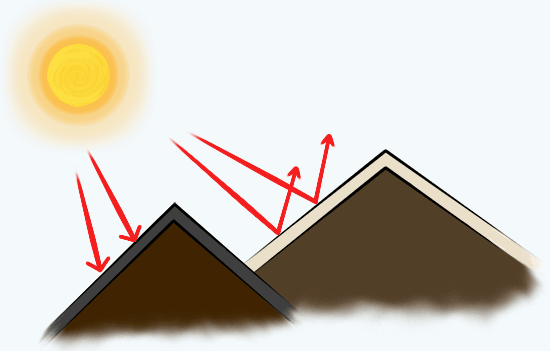Elemental Trading, Part 1: Roofs
- Clyde Anderson
- Jan, 15, 2016
- Efficient Design Elements
- Comments Off on Elemental Trading, Part 1: Roofs
This article is the first instalment of a three-part series examining elemental trading in a Verification Method (JV3) Thermal simulation. The series discusses the effect solar absorptance, insulation and thermal mass have on the performance of the building envelope. In this first article we’ll look at the roof. But first, let’s explain a few terms in case you’re not up to speed with all the lingo in the building industry. 
Solar absorptance is a number between 0 and 1 that measures how well a material’s surface absorbs solar energy. This is primarily (but not completely) affected by the colour of the material. Different colours of the same material have different values and a lighter colour means a lower solar absorptance. For example, 0.2 is brilliant white, while 0.9 is dark brown. Actual material solar absorptance values are a little more complex as they also include the material’s absorption in the Infra-Red and Ultra-Violet spectrums, which are invisible to the naked eye. So for simplicity, we’ll be referring to the different roof colours as just their solar absorptance numbers in this article.
Thermal mass is the ability of a building material to absorb and hold onto heat energy. A rough rule of thumb is that the heavier a material is, the more thermal mass it has. High density materials (such as concrete) have a high thermal mass, whereas lightweight materials (such as wood) have lower thermal mass.
We used DesignBuilder to model three different locations for the JV3 simulation: Darwin, Brisbane and Melbourne. These represent hot, warm/cool and cold climates. Buildings operated at other conditions will, of course, have different results. We modelled an office building measuring 30m × 15m × 3.5m with the longest-side facing North. We investigated the building envelope (roof, external walls and suspended floor), with varying solar absorptances, insulation and thermal mass. We also compared heat transfer (kWh) against the JV3 Reference Building – which is a basic structure that meets the DTS requirements of the Code.
You can see the annual total heat transfer (kWh) for different roofs in the graphs below. A positive number means that heat is transferring into the building, while a negative number means that heat is transferring out of the building. This heat transfer must be balanced by either artificial cooling, artificial heating or heat transfer in the opposite direction from other elements. We made all the graphs have identical scales to so you can easily make comparisons between locations.
Graphs of Roof Colour vs Building Energy Consumption

Results
There’s all sorts of interesting insights we can learn from these graphs.
Solar Absorptance: As you’d expect, the solar absorptance used in the building makes a huge difference. Darker colours result in hotter buildings, while lighter colours result in cooler buildings. Using certain colours in certain climates will reduce your building’s thermal performance. The optimum colour for the highest benefit depends on the building’s insulation, thermal mass and climate. As Brisbane is a mild climate, you can still use most colours providing you use insulation. In Melbourne you can get away with less insulation when you have a darker roof colour to minimise the need for heating, and in Darwin a lighter roof colour helps minimise the need for cooling.
Thermal Mass: If the roof is not insulated, there’s a significant variation between the annual total heat transfer between metal and concrete. This shows that thermal mass can play an important role in thermal performance in some scenarios. However if the roof is insulated, there’s little difference between the two materials. Thus, most of the beneficial thermal mass of a concrete roof is lost when it’s insulated.
Insulation: Adding roof insulation reduces the heat transfer through the roof (which hopefully shouldn’t come as a surprise to you). However, what may be surprising is that increasing roof insulation is not always beneficial! For example, In Darwin, using no insulation and a light colour helps with the night-time cooling effect to lower the building’s total Energy Consumption. Likewise, in Melbourne, using no insulation and a very dark colour may in some scenarios reduce the annual heat loss.
As always, the optimum performance of your specific building will depend on a combination of the most suitable solar absorptance, insulation and thermal mass of each element. Every building really is different!
Reference Building and Elemental Trading
In a Deemed-to-Satisfy report, elemental trading is not possible because every separate element needs to perform the same or better than the minimum Code requirements. However, to comply with a JV3 assessment, only the Annual Energy Consumption of the proposed building as a whole needs to be less than the Reference building. This lets you trade the benefits between elements – you can choose elements which perform better than the DTS minimum requirements in one area and use that to offset other elements that are less than DTS minimum requirements. For example, it’s possible to achieve a Building Solution by trading non-compliant DTS insulation for:
- Better than DTS-compliant glazing
- Better than DTS surface solar absorptance
- Better than DTS in available thermal mass
Despite having a non-DTS complying element, the proposed building can still comply with NCC Performance Requirement JP1 with a JV3 assessment if your Annual Energy Consumption is less than the Reference Building. This means a Verification Method assessment can offer substantial savings in construction costs. In our experience, we frequently find that a JV3 assessment can provide a more economical Building Solution for your project than a DTS assessment.
If you liked this article, be sure to check out Part 2 which covers external walls, and Part 3 which covers external floors. And don’t forget to Subscribe to our Newsletter to be notified of future articles like these!
